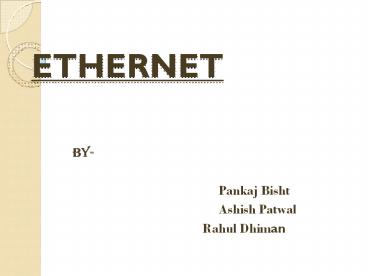ETHERNET - PowerPoint PPT Presentation
Title:
ETHERNET
Description:
ETHERNET By-Pankaj Bisht Ashish Patwal Rahul Dhiman Ethernet (cont..) It is a frame based Computer network Technology for Local Area Networks. This is covered by the ... – PowerPoint PPT presentation
Number of Views:139
Avg rating:3.0/5.0
Title: ETHERNET
1
ETHERNET
- By-
- Pankaj Bisht
- Ashish Patwal
- Rahul
Dhiman
2
Ethernet (cont..)
- It is a frame based Computer network Technology
for Local Area Networks. - This is covered by the IEEE 802.3
- standard that defines what is commonly known
as the CSMA/CD protocol.
3
Ethernet Overview (contd.)
- Ethernet by definition is a broadcast protocol
- Any signal can be received by all hosts
- Switching enables individual hosts to communicate
- Network layer packets are transmitted over an
Ethernet by encapsulating - Frame Format
4
Ethernet (cont..)
- Three data rates are currently
- defined for operation over optical fiber and
twisted-pair cables - 10 Mbps10Base-T Ethernet
- 100 MbpsFast Ethernet
- 1000 MbpsGigabit Ethernet
- 10-Gigabit Ethernet is under development.
5
Characterstics ..
- There are other technologies but Ethernet has
survived as the major LAN technology because its
protocol has the following characteristics - Is easy to understand, implement, manage,
and maintain - Allows low-cost network implementations
- Provides extensive topological flexibility
for network
installation.
6
Our Focus is Ethernet
- History
- Developed by Bob Metcalfe and others at Xerox
PARC in mid-1970s
7
The CSMA/CD Access Method..
- Carrier Sense Multiple Access / Collision
Detection, a set of rules determining how network
devices respond when two devices attempt to use a
data channel simultaneously (called a collision).
Standard Ethernet networks use CSMA/CD to
physically monitor the traffic on the line at
participating stations. If no transmission is
taking place at the time, the particular station
can transmit. If two
8
The CSMA/CD Access Method
- stations attempt to transmit simultaneously,
this causes a collision, which is detected by all
participating stations. After a random time
interval, the stations that collided attempt to
transmit again. If another collision occurs, the
time intervals from which the random waiting time
is selected are increased step by step. This is
known as exponential back off. CSMA/CD is a type
of contention protocol. Networks using the
CSMA/CD procedure are simple to implement but do
not have deterministic transmission characteristic
9
Collision Detection.
10
Ethernet Evolution
- 10 Base 5 (Thicknet) (Bus Topology)
- 10 Base 2 (Thinnet) (Bus Topology)
- 10 Base T (UTP) (Star/Tree Topology)
- 10 Base FL (Fiber) (Star/Tree Topology)
11
Ethernet Evolution
- 10BASE5 1983
- 10 Mbps
- 500 meter segment length
- Signal-regenerating repeaters
- Thick Coax
- Advantages Low attenuation, excellent noise
immunity, superior mechanical strength - Disadvantages Bulky, difficult to pull,
transceiver boxes too expensive - Wiring represented a significant part of total
installed cost.
12
Ethernet BUS Topology
13
Ethernet Evolution
- 10BASE2 Cheapernet 1985
- 10 Mbps
- 185 meter segment length
- Signal-regenerating repeaters
- Transceiver was integrated onto the adapter
- Thin Coax (coax thinner and lighter)
- Advantages Easier to install, reduced hardware
cost, BNC connectors widely deployed ? lower
installation costs. - Disadvantages Attenuation not as good, could not
support as many stations due to signal reflection
caused by BNC Tee Connector.
14
Ethernet Evolution
- 1BASE5 StarLAN 1987
- 1 Mbps
- 250 meter segment length
- Signal-regenerating repeaters
- Transceiver integrated onto the adapter
- Hub-and-Spoke topology (star topology)
- Two pairs of unshielded twisted pair
- Advantages Since four or more UTP are ubiquitous
in buildings, it is easier to use installed
wiring in the walls. Telephone wiring is
hierarchical ? can use wiring closets.
15
Ethernet Evolution
- 10BASET 1990 Most popular
- 10 Mbps
- 100 meter segment length
- Signal-regenerating repeaters
- Transceiver integrated onto adapter
- Two pairs of UTP
- Hub-and-spoke topology Hub in the closet
- Advantages could be done without pulling new
wires. Each hub amplifies and restores incoming
signal.
16
Ethernet STAR Topology
17
Open system interconnection
- International Standard Organisation (ISO) has
proposed Open System Interconnection(OSI)
reference model which provides a framework of
data communication protocols.OSI model addresses
the problem of interconnection of different
computer and associated devices.
18
Open System Interconnection Model
Application
Presentation
Session
Transport
Network
Data Link
Physical
Application
Presentation
Session
Transport
Network
Data Link
Physical
Network
Data Link
Physical
Network
Data Link
Physical
19
OSI Layers
- PhysicalTo send the data bit stream over
Communication network. - Data LinkTo recover from Transmission error.
- NetworkConcerned with routing and congestion
control. - TransportTo receive the data from session layer
and divide it into pieces to pass it to network
layer.
20
OSI Layers (contd..)
- SessionEstablishes a session for communication
between two hosts. - PresentationServes as an interface between
Application and Communication network. - ApplicationTo provide the facility to use the
other layer.
21
Advancement.
- A newer version of Ethernet, called 100Base-T
(or Fast Ethernet), supports data transfer rates
of 100 Mbps. And the newest version, Gigabit
Ethernet supports data rates of 1 gigabit (1,000
megabits) per second.

